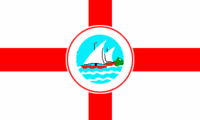Thousand Emirates

| |
| Cities: | |
| Capital: | Aden |
| Other: | Dubai, Abu Dhabi, Muscat, Sanna, al-Mukalla, Doha, al-Bahrayn |
| Languages: | |
| Official: | Arabic (national), South Arabian (regional) |
| Others: | Bengali, Urdu, Dari (among the Indian immigrants in the oil producing emirates) |
| High Emir: | Faraj Said Ibn Ashur |
| Area: | approx 535 000 sq.miles |
| Population: | 23 million South Arabians or Yemenis |
| Independence: | from Federated Kingdoms |
| Date: | 1971 |
| Currency: | 1 Rial = 40 buqsha = 80 halala = 160 zalat |
| Organizations: | League of Nations, COPEN, Arab Community |
Administration
Government
Confederation of absolute monarchies. The country is ruled by the High Emir, elected for a five year term among the several emirs gathered at the Majlis.
None of the emirates should have a consecutive High Emir ruling the federation, in order to balance the powers between the emirates. The High Emir does not have much power as he is reduced just to a figurehead to represent the country abroad.
Administrative divisions
An enormous number of emirates, internally independent and ruled by their emirs with absolute political power although some emirates are also secular.
History
Yemen
Yemen was one of the oldest centers of civilization in the Near East. Between the 12th Century BCE and the 6th Century CE it was alternately held by the Mineans, Sabeans, and finally the Himyar Kingdom, who controlled the very lucrative spice trade.
In ancient times, Yemen was comprised of a number of kingdoms, including Saba or Sheba, as referenced in the Bible, Qataban and Hadhramaut. In the 5th Century CE the Kingdom of Himyar grew to be a powerful nation with boundaries similar to that of modern-day Yemen and extended its influence into the Hijaaz. Dhu Nuwas, King of Himyar, changed the state religion to Judaism in the beginning of the 6th Century and politely but firmly expelled the Christians.
Binding with Judea against Islamic attack, Himyar remained independent (although during late 1700's was part of Solomon Ben Ilya's Israel) and Jewish.
The Trucial Sheikhdoms
The Trucial Sheikhdoms were formed from the group of tribally organized Arabian Peninsula sheikhdoms along the southern coast of the Persian Gulf and the north-western coast of the Gulf of Oman.
This area was converted to Islam in the 7th century; for centuries it was embroiled in dynastic disputes. It became known as the Pirate Coast as raiders based there harassed foreign shipping, although both European and Arab navies patrolled the area from the 17th century into the 19th century. Early Kemrese expeditions to expand trade in the East met and negotiated for nearly a year to achieve peace. The next year, a general peace treaty was signed to which all the principal shaikhs of the coast adhered.
Raids continued intermittently until 1835, when the shaikhs agreed not to engage in hostilities at sea. In 1853, they signed a treaty with the Federated Kingdoms, under which the sheikhs (the "Trucial Sheikhdoms") agreed to a "perpetual maritime truce." It was enforced by the Federated Kingdom, and disputes among shaikhs were referred to the British for settlement.
Primarily in reaction to the ambitions of other European countries, the Federated Kingdoms and the Trucial Sheikhdoms established closer bonds in an 1892 treaty, similar to treaties entered into by the F.K. with other Gulf principalities. The shaikhs agreed not to dispose of any territory except to the Federated Kingdoms and not to enter into relationships with any foreign government other than the Federated Kingdoms without its consent. In return, the British promised to protect the Trucial Coast from all aggression by sea and to help out in case of land attack.
In 1955, the Federated Kingdoms sided with Abu Dhabi in the latter's dispute with Saudi Arabia over the Buraimi Oasis and other territory to the south. A 1974 agreement between Abu Dhabi and Saudi Arabia would have settled the Abu Dhabi-Saudi border dispute; however, the agreement has yet to be ratified by the Thousand Emirates Government and is not recognized by the Saudi Government. The border with Oman also remains officially unsettled, but the two governments agreed to delineate the border in May 1999.
In 1968, the F.K. announced its decision, reaffirmed in March 1971, to end the treaty relationships with the seven Trucial Shaikhdoms that had been under British protection.
The nine formed a union of Arab Emirates which became fully independent on December 1, 1971. On December 2, 1971, six merged with the Thousand Emirates. The seventh, Ras al-Khaimah, joined in early 1972, and Qatar and Bahrain ratified the Union, joining in mid and late 1972, respectively.
The Federation of Aden
English protection
English rule started in 1839, when Royal Marines occupied the port of Aden. During the XIX century English signed treaties of protection with the many sheikdoms and emirates located between the Jewish Kingdom of Yemen and the Trucial Sheikhdoms, under Kemrese protection. Together with the Jewish kingdom this entire region on the south-easterly end of Arabia was (and still is) known as the Yemens.
The Ethiopian Liberation War
During the Ethiopian Liberation War the Ethiopians planned and carried out the invasion of Aden in early 1943. This important FK port and air base was heavily damaged and was overtaken by the invading forces which damaged seriously the British ability to fight Ethiopia.
Friendly relations were established with the emirates surrounding Aden. Thus many of the emirates became supportive of Ethiopians rather than the Federated Kingdoms and internal conflicts between the emirates started (actually, more related to some emirs wanting to acquire more lands and influence rather than actual international politics).
As result of the Somali Revolt, with much hand from FK propaganda, Ethiopia lost its influence over the emirates as Ethiopians started to conscript troops from the occupied territories and allies. Socotra declared its independence on the April 15th of 1944 and Ethiopia wasn't able to reinstate its rule over the island as Ethiopian navy was decimated in battles by the FK navy.
The formerly friendly emirates in the Arabic peninsula drifted away from Ethiopia and requested immediate withdrawal from Egypt and negotiations with the Somali rebels. As Ethiopia didn't answer such requests the emirate of Al-Mukalla invaded and overtook Aden on April 1944. Later Ethiopia signed a treaty of friendship with Al-Mukalla (which recognized the new sovereignty over Aden and didn't allow Al- Mukalla to use this port against Ethiopia so as the Ethiopians should provide military help to Al Mukalla as the emirate was at war with its neighbours). Ethiopia also recognized the independence of Socotra.
Al Mukalla would also become a founding member in May 1945 of the African Alliance, an Ethiopian led-organization on which its members decided to cooperate in various fields and to "spread the word of Free Africa" (support the pro-Ethiopian rebels in countries of Africa).
Later as the war was over, in 1949, Aden returned to English rule for more ten years.
The federation
Aden stayed ruled as a separate colony until 1959 and during was always an important and prosperous port and those tribal states formed a federation under FK protection, the Federation of Aden. All of them were gathered in the Federation of Aden in 1959, still under protection, which at the time also included Socotra Island.
Aden's people made riots against this unification, not wanting the change of status and the mixture with those tribal statelets. Also in that year the United Arab Republic, ruled by the pan-arabist Gamal Abdel Nasser, gave support with funds and military to local nationalist guerrillas which wanted to expel the English from the territory during the Yemens War.
In 1967 oil started to be explored in the east part of the federation, Oman, which since then obtained a certain economic prosperity.
The Trucial Sheikhdoms and the Federation Aden became independent in 1971, and together with Yemen merged due to untrust to its powerful northern neighbour, Saudi Arabia, in a new country called the Thousand Emirates. This new country was formed as a very loose federation but always with close ties to the former protecting nations.
After independence
FK kept in Aden and the Musadam Peninsula important military bases to protect the sea route to Far East through the Suez Canal and its interests on the Arabian Peninsula (that means oil). Socotra decided to stay under FK protection. Since then, the Thousand Emirates are a very loose federation of many emirates (looser than the Holy Roman Empire) with different levels of development. Oman, Dubai, Abu Dhabi, Sharjah, Bahrain, Qatar (due to oil industry) and Aden (due to its port activities) became prosperous but the many others between them stay rather underdeveloped and with not many resources.
The Thousand Emirates maintain disputes with Saudi Arabia along its desert borders which never were correctly designed during FK protection. International mediation about these disputes, made mostly by the Arab Community, was never much successful. Also its several components maintain lots of conflict between them, mostly on a diplomatic basis, so as some low level espionage too, but never approaching armed conflict, since that would de-unify the country in the eyes of the outside world. The emirates often are unable to find common positions about politics and other subjects. An example was the support given by some of the emirs to Saddaam Hussayn regime in Iraaq, during the Persia-Iraaq War.
Borders
Saudi Arabia and Indian Ocean (Aden Gulf, Oman Gulf, Persian Gulf and Arabian Sea).
The Thousand Emirates maintain border disputes over the Rub al-Khali Desert with Saudi Arabia.
Economy
See also: The Gulf Leopards
Main economical activities are oil production and related industries plus trade and banking in some of the richer emirates. Due to poverty in most of the emirates, many people migrated internally to Aden and to the oil producing emirates so as externally to Saudi Arabia and Kuwayt. In some poor emirates natural pearls production are still important.
Philately
See main article: Postal history of the Thousand Emirates
The poorer emirates found in philately a new resource in the last years. Their emirs contracted european and american printing companies to make regional stamps which became known as "dunes" among worldwide philatelists. These stamps are known to be large, much colorful and with themes strange to arabic culture such as the space conquest, the Winter World Games, Christmas, Easter, etc.
Culture
Emirates
- Himyar (Jewish)
- Najran (Ismaili Shia)
- Yemen (Zaidi Shia)
- Socotra (Christian, codominium between England and Qishn).
- Asir
- Mahra
- Kathiri
- Qu'aiti
- Upper Yafa
- Al Busi
- Al Dhubi
- Hadrami
- Mawsata
- Maflahi
- Al-Hawra
- Al-Irqa
- Al-Tarim
- Aden
- Alawi
- Aqrabi
- Audhali
- Beihan
- Dathina
- Dhala
- Fadhli
- Haushabi
- Lahej
- Lower Aulaqi
- Lower Yafa
- Maflahi
- Shaib
- Upper Aulaqi Sheikhdom
- Upper Aulaqi Sultanate
- Wahidi Balhaf
- Abu Dhabi
- Dubai
- Ajman
- Kalba
- Ras Al Khaimah
- Umm Al Quwain
- Fujairah
- Bahrayn
- Qatar
- Sharjah
- Masqat
- Oman
- Sohar
- Dhofar
Language
Arabic is official national language. Several South Arabian languages (written in cursive Zabūr alphabet, see: [[1]]) have official regional status, notably the Himyaritic, the Mehri and the Shehri. Other South Arabian languages are spoken by some hundreds of people (Harsusi, Bathari, Hobyot and Razihi). English and Brithenig are understood in the main cities.
Religion
Sunni Islam including wahhabi, Shiite Islam and Judaism, mostly in Himyar. Also some Christians, who have their own emirate.

